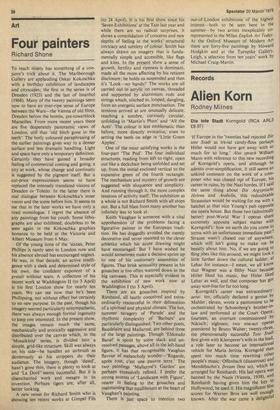Art
Four painters
Richard Shone
To reach ninety has something of a conjuror's trick about it. The Marlborough Gallery are applauding Oskar Kokoschka with a birthday exhibition of landscapes and cityscapes; the first in the series is of Dresden (1923) and the last of Istanbul (1968). Many of the twenty paintings seem now to have an over-ripe sense of Europe between the Wars—the Vienna of old films. Dresden before the bombs, pre-towerblock Marseilles. From more recent years there are five desperately panoramic views of London, still that 'old bitch gone in the teeth'. The hotly coloured paraphrasing of the earlier paintings gives way to a denser surface and less dramatic handling. Light and space have only a temporary definition. Certainly they have gained a broader feeling of commercial coming and going, a city at work, whose change and continuity is suggested by the pigment itself. But a cut-price expressionism seems to have replaced the intensely translated visions of Dresden or Toledo. In the latter there is real dialogue between Kokoschka's inner vision and the scene before him. It seems to me that in the later works we have only a tired monologue. 1 regret the absence of any paintings from his youth. Some lithographs are also exhibited, doubtless to be seen again in the Kokoschka graphics bonanza to be held at the Victoria and Albert Museum from 6 May.
Of the young lions of the 'sixties, Peter Phillips is rarely seen in London now and his absence abroad has encouraged neglect. He was, in that decade, an active intelligence with a sleek and determined style of his own, the confident exponent of a gestalt without tears. A collection of his recent work at Waddington II (to 3 April) is his first London show for nearly ten years. We can see now that he's been Phillipsing, not without effect but certainly to no new purpose. In the past, though his imagery seemed particularly unsympathetic, there was always enough formal ingenuity to keep one interested. In the present show, the images remain much the same, mechanically and erotically aggressive and distributed over the canvas which, in the 'Mosaikbild' series, is divided into a simple, grid-like structure. Skill was always on his side—he handles an airbrush as dexterously as his strippers do their audience. The imagery, though 'dated', hasn't gone thin, there is plenty to look at and 'La Dore' seems successful. But it is disenchanted work and meagre in its invention. Perhaps tigers are, after all, better looking.
A new venue for Richard Smith who is showing ten recent works at Gimpel Fils (to 24 April). It is his first show since his 'Seven Exhibitions' at the Tate last year and while there are no radical surprises, it shows a consolidation of concerns and new depths of feeling in the works' structural intricacy and subtlety of colour. Smith has always drawn on imagery that is fundamentally simple and accessible, like flags and kites. In the present show a sense of growth, fertility and ripeness is dominant, made all the more affecting by his reticent disclosure; he holds us suspended and then it's `Look—no hands!' The works are all carried out in acrylic on canvas, threaded and supported by aluminium rods and strings which, stitched in, looped, dangling, form an energetic surface punctuation. The tensions arrived at are unusually delicate, reaching a sombre, curiously circular, unfolding in 'Martin's Plum' and 'All the Aces'. The colour is less emblematic than before, more directly evocative, even to setting the teeth on edge in 'Little Green Apples'.
One of the most satisfying works is the four-part 'The Pod'. The four individual structures, reading from left to right, open out like a deckchair being unfolded and set up, from the initial enclosed vertical to the expansive green of the fourth rectangle. The mechanism and mystery of growth are suggested with eloquence and simplicity. And running through it, the more complex tensions of activity itself. The exhibition as a whole is not Richard Smith with all stops out. But a full blast from many another has infinitely less to look at.
Keith Vaughan is someone with a vital apprehension of the problems facing a figurative painter in the European tradition. He has doggedly avoided the merely decorative and never resorted to the clever athletics which his acute drawing might have encouraged. But I have wished he would sometimes make a decisive sprint up to one of his customary assemblies of figures. That brisk sensuality present in his gouaches is too often watered down in the big canvases. This is especially evident in the exhibition of new work now at Waddington I (to 3 April).
There are six gouaches inspired by Rimbaud, all tautly conceived and extraordinarily resourceful in their delineation of a spiritual and physical climate. The hot, summer savagery of 'Parade' and the rhythmic complexity of `Barbare' are particularly distinguished. Two other poets, Baudelaire and MaHarm& are behind three of the large paintings. Though 'Eldorado Banal' is spoilt by some slack and unresolved passages, above all in the left-hand figure, it has that recognisable Vaughan flavour of melancholy wonder—`Regarde, apres tout, c'est une pauvre terre.' The two paintings `Mallarrne's Garden' are perhaps excessively refined. I prefer the strong accents of 'Landscape with Figure', nearer in feeling to the gouaches and maintaining that equilibrium at the heart of Vaughan's painting.
There is just space to mention two out-of-London exhibitions of the highest interest—both to be seen here in the summer—by two artists inexplicably unrepresented in the Milan English Art Today. At the Oxford Museum of Modern Art there are forty-five paintings by Howard Hodgkin and at the Turnpike Gallery. Leigh, a selection from ten years' work by Michael Craig-Martin.


































 Previous page
Previous page